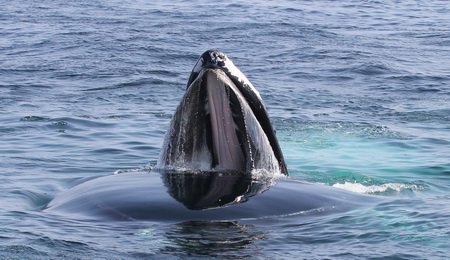After a week based in Boston, Song of the Whale and team headed out to Stellwagen Bank, off Cape Cod, to help conduct a tracking and photogrammetry (making measurements from photographs) project on humpback and fin whales. The project is in collaboration with a number of other organisations including NOAA and the Stellwagen Bank National Marine Sanctuary it aims to collect tracking data to better understand how whales use the water column, especially in relation to their prey, the sand eel, with the ultimate aim of helping inform measures to reduce collisions between whales and vessels, and entanglements of whales in fishing gear. The specific goal this year is to focus on surfacing feeding groups and mother and calf pairs to see if their techniques of utilising the food resources within the sanctuary vary between day and night.
We are now just a few days into the research cruise and we have been fortunate enough to have seen over 50 humpback whales each day, minke whales galore and several very friendly grey seals. The humpbacks observed so far have mostly been bubble-net feeding, which involves one whale diving below a shoal of sand eels and blowing a circle of bubbles around them which concentrate the prey into a narrow column. Other whales in the group then swim through the column of fish, gulping large quantities of water into their mouths before filtering out the fish using their baleen. This is an amazing activity to witness, a true display of animals engaging in co-operative behaviour.
Few tracking episodes have occurred so far due to complications with the suction cup tag, leaving the Song of the Whale crew plenty of time for Photo ID work, and trialling a new technique for photogrammetry. Photogrammetry, involves taking ID shots of whales, dorsal fins and flukes, with two lasers 100mm apart mounted on a camera lens. The dots from the lasers show up on the animal within the photo and can be used to measure the fluke width of the whale which is in turn used to estimate the overall length of the animal. This technique is a non-invasive way of understanding the size and age class of the animal. Trialling this technique on Stellwagen Bank, where the whales are so well known, allows us to test the accuracy of our results before applying the technique to lesser known populations.

Aboard SOTW, in addition to local whale researchers, are managers from sister sanctuaries in the Caribbean, here to learn about the successes of the Stellwagen Bank sanctuary in its 20th year. We have a just a week of this short research cruise left and hope we will have several more successful encounters with the graceful long-winged New Englanders (Megaptera novaengliae).

Sorry, comments are closed for this post.